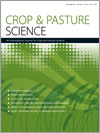Over 1000 viruses affect plants worldwide; 24 of these have arrived in New Zealand and infect pasture legumes and grasses. This paper reviews what is known of these viruses and the damaging effects they are having on pastures. The paper identifies knowledge gaps and makes recommendations relevant to New Zealand and other parts of the temperate world.

Crop and Pasture Science
Volume 65 Number 9 2014
CP14106High-yielding lines of wheat carrying Gpc-B1 adapted to Mediterranean-type environments of the south and west of Australia
Gpc-B1, a gene from a wild relative of wheat, has been suggested as a way of increasing the grain protein content of cultivated wheat without reducing grain yield. In experiments grown in the south and west of Australia, Gpc-B1 significantly increased grain protein content, with a negligible effect on grain yield. Lines were identified that were comparable to the check cultivar for grain yield, but with significantly higher grain protein contents, similar heading dates, and acceptable grain and test weights.
CP14011Tolerance to ion toxicities enhances wheat grain yield in acid soils prone to drought and transient waterlogging
Acid soils are prone to flooding early in growing season and also to late drought which both intensifies the adverse effect of ion toxicities in root growth and grain yield. Whether wheat varieties tolerant to ion toxicities with enhanced root growth under flooded acid soils also over perform the intolerant ones under drought were investigated. It was revealed that tolerance to ion toxicities conferred improved grain yield under severe drought which makes wheat crop resilient to widespread flooding followed by late drought in acid soils.
CP14034Cytochemical investigation at different microsporogenesis phases of male sterility in wheat, as induced by the chemical hybridising agent SQ-1
Chemical hybridising agents, such as SQ-1, are used for producing hybrid plant varieties. This study investigated the relationship between pollen nutrient metabolism and pollen abortion in SQ-1-induced male sterile lines of wheat by using semi-thin sectioning and cytochemistry. SQ-1 probably hampered nutrient metabolism in the anthers, leading to decreased nutrient supply and abnormal intine formation, ultimately resulting in pollen abortion.
CP13412Nitrogen timing and rate effects on growth and grain yield of delayed permanent-water rice in south-eastern Australia
Changes in water management practices are leading to significant increases in rice water productivity. Shifting rice sowing methods from aerial to drill sowing and delaying when continuous flood is applied to the crop reduces evaporation losses and increases water productivity, but also requires some modification to nitrogen management practices. Nitrogen management of drill sown rice with delayed permanent water is simple, cost effective and leads to high nitrogen use efficiency.
CP13391Determination of nitrogen and potassium content in greenhouse tomato leaves using a new spectro-goniophotometer
We proposed a method for the diagnosis of crop nutrient stress. A new spectro-goniophotometer system was invented and used for assessing the feasibility of determining the nitrogen (N) and potassium (K) contents of fresh greenhouse-grown tomato leaves. This method allows for in-depth study of plant nutrient status and rapid detection at the single-leaf scale and has theoretical and practical significance.
CP13433Do lignite-derived organic amendments improve early-stage pasture growth and key soil biological and physicochemical properties?
Commercial agricultural amendments derived from lignite (brown) coal are marketed as having growth-promoting and soil health benefits. Application of a range of these products to lucerne and ryegrass in two contrasting soils gave variable results in terms of these measures. The results will contribute to understanding in which soils and plant types these products can be of most benefit.
CP14067Drought resistance of Trifolium repens×Trifolium uniflorum interspecific hybrids
White clover has a high soil moisture requirement, which limits its use and productivity in dry environments and during drought. However, in hybrids between white clover and Trifolium uniflorum the negative effects of drought stress were significantly reduced, including impacts on dry matter production and shoot death. Interspecific hybridisation with close relatives may, therefore, provide a means of developing improved white clover cultivars with greater adaptation to more marginal environments and changing climatic conditions.
CP14065An approach to crop yield improvement through diagnostic systems research in a winter-dominant rainfall environment
Factors likely to be limiting crop and pasture production in the high rainfall zone of Western Australia were identified on two farm sites using soil and plant tests and farmer experience. Factorial combinations of treatments to address the identified constraints were tested over five years. The factors limiting production at each site varied according to the seasons but strategies could be identified to raise the crop and pasture yields to the rainfall-limited potential.
CP14083Embryogenesis and plant regeneration of the perennial pasture and medicinal legume Bituminaria bituminosa (L.) C.H. Stirton
Bituminaria bituminosa (common name tedera) is a drought-tolerant perennial pasture species of agronomic and pharmaceutical interest for Mediterranean climates. Protocols for plant regeneration from embryogenic calli of leaves, petioles and anthers are reported. These protocols will facilitate further improvement for agricultural applications and the efficient exploitation of the species for pharmaceutical uses.



